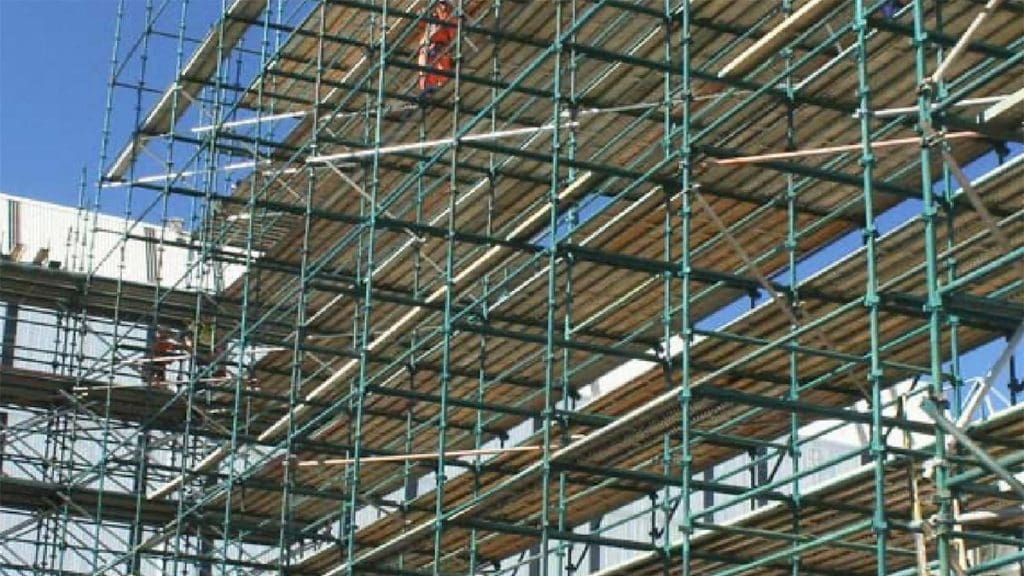Get the Best Scaffolding Cobham Services for Your Building Projects
Get the Best Scaffolding Cobham Services for Your Building Projects
Blog Article
Discovering the Different Kinds Of Scaffolding Utilized in Building Jobs
The building industry depends heavily on numerous types of scaffolding to satisfy certain project requirements, each offering distinct advantages and applications. Conventional frame scaffolding gives a tough foundation for general jobs, while suspended scaffolding is crucial for deal with skyscraper structures. Other choices, such as system and rolling scaffolding, deal with efficiency and movement, specifically. In addition, the cantilever variant confirms vital in metropolitan settings where area is constricted. Recognizing the nuances of these scaffolding kinds is important for enhancing safety and security and performance on building and construction websites, triggering a better examination of their unique features and applications.

Conventional Frame Scaffolding
Standard structure scaffolding is just one of the most extensively made use of methods in the building and construction market as a result of its effectiveness and adaptability. This system includes straight and upright structures that are assembled to create a stable system for workers and materials. The major elements include vertical articles, horizontal ledgers, and diagonal dental braces, which with each other provide a solid framework that can sustain substantial loads.
One of the essential benefits of typical frame scaffolding is its versatility to numerous construction tasks, ranging from household buildings to large commercial frameworks. The modular style allows for very easy assembly and disassembly, making it efficient for both short-term and long-lasting projects. Additionally, the system can be tailored in height and width, fitting various building designs and site problems.
Security is critical in scaffolding applications, and typical framework systems are geared up with guardrails and toe boards to stop drops and make sure employee security. Routine examinations and adherence to safety guidelines are vital in maintaining the honesty of the scaffold (Scaffolding). On the whole, standard frame scaffolding remains a basic selection in the construction sector, supplying a trusted platform for labor and boosting general task performance

Suspended Scaffolding
Put on hold scaffolding provides a distinct service for building and construction jobs that call for accessibility to elevated surface areas, especially in circumstances where standard frame scaffolding might be unwise. This kind of scaffolding is commonly put on hold from the roofing system or upper levels of a framework, utilizing a system of ropes, wheels, and platforms to produce a functioning area that can be gotten used to numerous heights.
One of the key advantages of suspended scaffolding is its flexibility. It can be conveniently rearranged or lowered to fit adjustments in construction needs, making it ideal for tasks such as home window setup, frontage job, and upkeep on skyscrapers. Additionally, the marginal impact of put on hold scaffolding permits for better use of ground area in city environments, where room is frequently restricted.
Safety is an essential consideration in the usage of put on hold scaffolding. Appropriate rigging and anchoring systems must be used to make certain stability and stop crashes. Operators must also be learnt the secure usage of this equipment. In general, put on hold scaffolding gives a effective and effective solution for accessing hard-to-reach locations in different building and construction situations, improving both productivity and safety and security on website.
System Scaffolding
System scaffolding, frequently considered as a modern-day option in the scaffolding market, contains pre-engineered components that can be swiftly put together and adapted for different construction projects. Scaffolding. This kind of scaffolding is defined by its modular design, which enables convenience and efficiency on job websites, fitting structural requirements and different heights
Commonly made from high-strength steel or light weight aluminum, system scaffolding supplies enhanced resilience and security. The elements consist of upright articles, straight journals, and angled dental braces, which interconnect safely, guaranteeing a robust framework. The style commonly incorporates standardized fittings, streamlining setting up and disassembly processes, thereby minimizing labor time and prices.

Rolling Scaffolding
Rolling scaffolding is a flexible choice to standard fixed scaffolding, created for movement and ease of usage on building sites. This kind of scaffolding is composed of a platform supported by structures with wheels, permitting employees to easily relocate it as required. The flexibility attribute substantially enhances efficiency, as it lessens downtime linked with taking apart and assembling taken care of scaffolding.
Typically created see this site from lightweight materials such as aluminum or steel, rolling scaffolding offers a tough yet mobile service for tasks calling for frequent repositioning - Scaffolding. It is specifically beneficial in tasks such as painting, drywall installment, and electrical work, where access to different elevations and locations is necessary
Safety is critical in rolling scaffolding design, with features such as securing wheels to stop unintended movement when being used, and guardrails to safeguard employees from falls. In addition, numerous designs are flexible in height, accommodating different task needs.
Cantilever Scaffolding

The layout of cantilever scaffolding normally includes utilizing arms or braces secured to a structure or structure, allowing the system to prolong outward safely. Safety and security is paramount; thus, these scaffolds need to be engineered to endure environmental problems and different tons. Regular inspection and maintenance are vital to guarantee architectural honesty and worker safety.
Cantilever scaffolding is favored for its adaptability and reliable use area, making it a prominent option in urban environments where room restraints are common. Moreover, it assists in simpler access to high elevations, eventually contributing to the general efficiency of building and construction tasks. Just like all scaffolding kinds, correct training and adherence to security requirements are essential for employees making use of cantilever scaffolding.
Verdict
To conclude, the varied types of scaffolding utilized in construction tasks each offer distinct objectives tailored to specific site requirements. Traditional framework scaffolding offers stability, while suspended scaffolding uses convenience for elevated jobs. System scaffolding promotes quick assembly, and rolling scaffolding enhances flexibility for differing workplace. Cantilever scaffolding effectively resolves obstacles in urban settings. Comprehending blog here these scaffolding kinds is crucial for optimizing safety and efficiency in construction, ultimately adding to the effective completion of jobs.
Typical frame scaffolding gives a strong foundation for general jobs, while put on hold scaffolding is necessary for job on high-rise structures.Rolling scaffolding is a flexible option to standard fixed scaffolding, developed for mobility and ease of use on building and construction sites. As with all scaffolding kinds, correct training and adherence to safety requirements are vital for employees utilizing cantilever scaffolding.
Traditional frame scaffolding gives security, while suspended scaffolding provides versatility for raised jobs. System scaffolding assists in fast setting up, and rolling scaffolding enhances wheelchair for varying work atmospheres.
Report this page